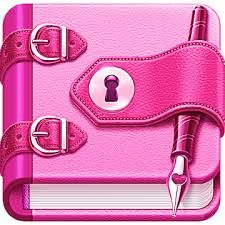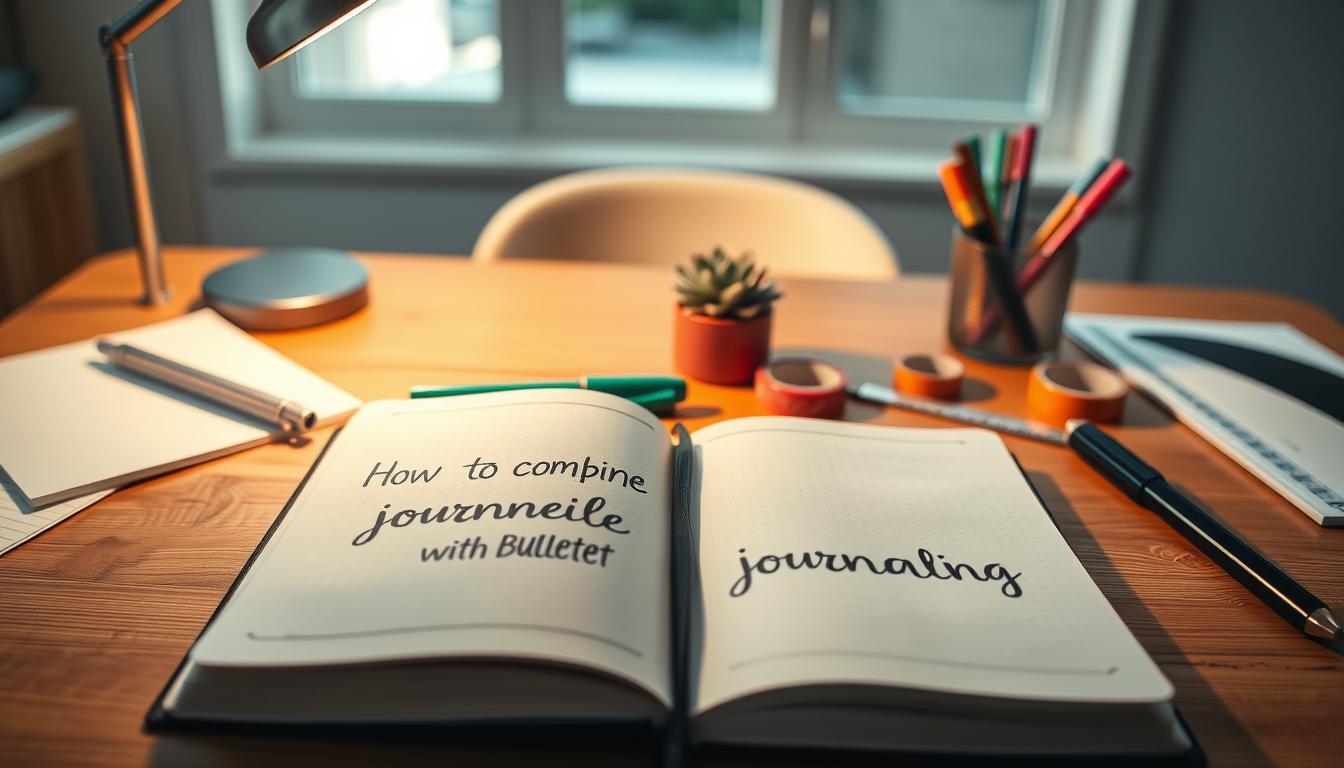Feeling swamped by jumbled thoughts? Bullet journaling might be your answer. It’s a creative planning method that mixes traditional journaling with a flexible system.
Regular journaling helps mental health. It aids in processing emotions and managing anxiety. Bullet journaling adds structure to this approach. Together, they support emotional well-being and boost productivity.
This method is highly adaptable. It works for work tasks, personal goals, or emotional clarity. A bullet journal can change how you view daily life.
Picture a system that logs thoughts, tracks habits, and encourages reflection. That’s what you get when you mix traditional and bullet journaling techniques.
Let’s explore how to blend these methods. You’ll create a tool for productivity and self-discovery. Get ready to understand yourself better and manage life creatively.
Understanding the Basics of Bullet Journaling
Bullet journaling has transformed personal organization for many. It’s a creative planning approach developed by Ryder Carroll in 2013. This analog method turns note-taking into a powerful personal management system.
What is Bullet Journaling?
Bullet journaling is a flexible method of rapid logging. It helps track the past, organize the present, and plan the future. This approach uses a physical notebook for deeply personalized organization.
Key Components of a Bullet Journal
A typical bullet journal includes several essential elements:
- Index: Your personal directory for quick navigation
- Future Log: Tracking commitments up to six months ahead
- Monthly Log: Organizing tasks and events
- Daily Log: Capturing daily tasks, events, and notes
- Collections: Custom pages for specific topics or interests
Benefits of Bullet Journaling
Bullet journaling offers remarkable advantages for personal productivity:
- Improved mental clarity
- Enhanced task management
- Increased self-awareness
- Creative personal expression
- Flexible organization system
Studies show 65% of bullet journal users gain more self-awareness and clarity. This unique system lets you design a personalized planning method.
Bullet journaling adapts to your needs and style. It’s a powerful tool for boosting productivity and self-understanding.
Getting Started with Your Bullet Journal
Bullet journaling can revolutionize your organization and creative journaling methods. This guide will help you create a personal system for capturing thoughts, tasks, and memories.
You’ll learn how to set up your journal effectively. We’ll cover choosing supplies and creating essential pages.
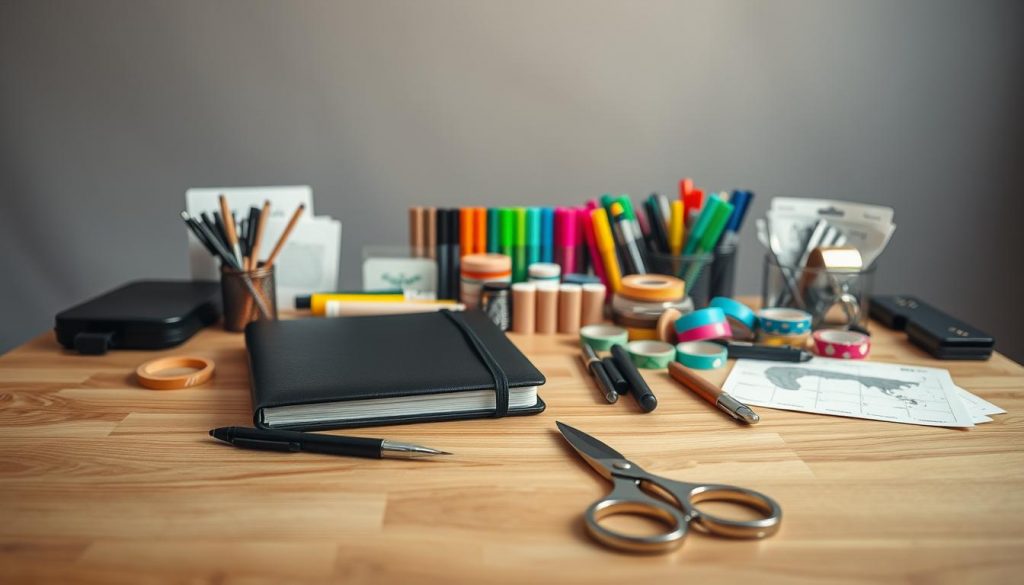
Choosing the Right Journal
Picking the perfect journal is key to your bullet journaling success. Look for quality paper that works with various writing tools.
Choose a size that fits your lifestyle and bag. Consider the binding style for easy writing.
Decide between dotted, lined, or blank pages. Each type offers unique benefits for your journaling style.
- Paper quality that supports different writing tools
- Size that fits your lifestyle and bag
- Binding style that allows easy writing
- Page type: dotted, lined, or blank
“The right journal is like a trusted companion in your organization journey.”
Essential Supplies You’ll Need
Your bullet journaling toolkit should include:
- Dotted or blank notebook
- Fine-tip pens
- Ruler
- Colored markers
- Washi tape
Setting Up Your First Pages
Build a strong foundation for your bullet journal with these key pages:
- Index page: Your organizational roadmap
- Future log for long-term planning
- Monthly spread to track goals
- Daily log for rapid logging
Your bullet journal is a flexible tool for creative expression and organization. Start simple and develop a system that fits your unique needs.
Experiment with different layouts and trackers. You’ll soon find what works best for your lifestyle and goals.
Integrating Traditional Journaling Techniques
Bullet journaling blends structured organization with creative self-expression. It can be a powerful tool for personal growth and reflection. By adding traditional journaling techniques, you can enhance your bullet journal experience.

Traditional journaling adds depth to your bullet journal. Reflective writing expands your daily logs beyond simple task tracking. It helps you explore your thoughts and emotions more thoroughly.
Streamlining Your Writing Process
Effective writing techniques can improve your journaling experience. They make it more meaningful and efficient. Here are some strategies to enhance your bullet journaling:
- Create dedicated pages for free-form writing
- Use prompts to spark deeper reflection
- Integrate writing techniques like stream of consciousness
Adapting Prompts from Traditional Journaling
Adapt classic journaling prompts to fit your bullet journal style. Here are some effective approaches:
- Morning pages adaptation
- Gratitude log integration
- Emotional tracking collections
Using Reflective Writing to Enhance Bullet Journaling
Reflective journaling provides deeper insights into your daily experiences. It can be a powerful mental health tool. Many bullet journal users report decreased stress levels from this practice.
Blending traditional and bullet journaling creates a more personal life record. Your journal becomes more than a planner. It’s a tool for self-understanding and personal growth.
Designing Your Bullet Journal Layout
A creative approach turns a simple notebook into a powerful organization tool. Your bullet journal reflects your unique personality and productivity style. It becomes more than just a planner.
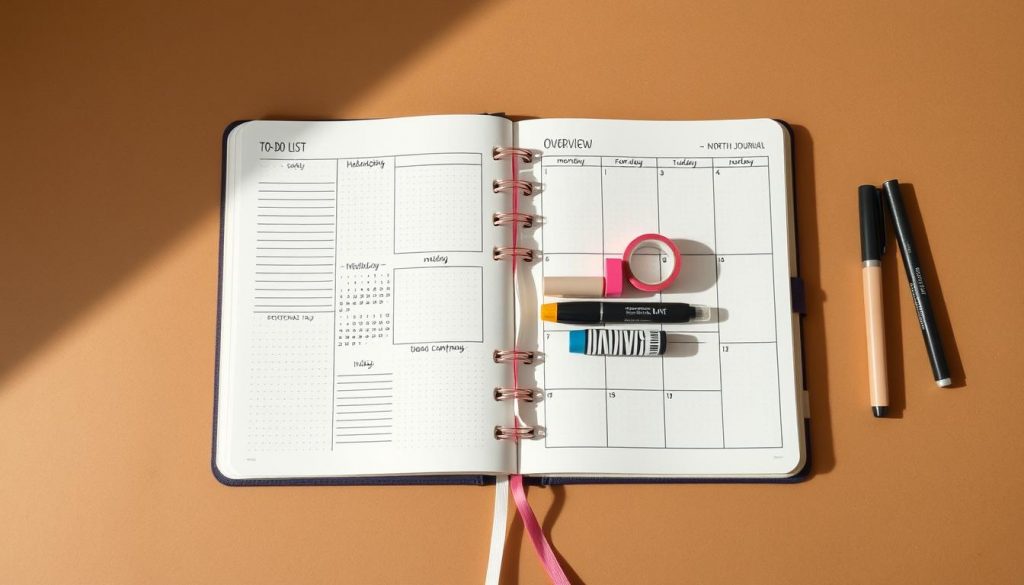
Effective bullet journaling balances structure and creativity. Studies show that personalizing layouts enhances the journaling experience. About 90% of users enjoy their journals more after customization.
Tips for Effective Page Layouts
- Create clear sections for different types of entries
- Leave white space for flexibility
- Use consistent formatting across pages
- Develop a layout that matches your personal workflow
Incorporating Creativity in Your Design
Creative journaling celebrates personal expression, not perfection. Your bullet journal can mix functional planning with inspiring artistic elements.
“Your journal is a canvas where organization meets imagination.” – Bullet Journal Enthusiast
Color Coding and Its Benefits
| Color | Purpose | Benefit |
|---|---|---|
| Blue | Work Tasks | Increases focus |
| Green | Personal Goals | Promotes growth tracking |
| Red | Urgent Items | Highlights priority |
Color coding helps you quickly identify different entry types. Visual organization can improve task management and reduce mental strain.
Your bullet journal is a personal tool. Try various layouts and embrace your creativity. Find a system that works best for you.
Tracking and Planning with Bullet Journaling
Bullet journaling boosts productivity and organization. It combines strategic planning with personal reflection. This powerful tool helps track habits and achieve goals.
Effective habit tracking needs a thoughtful approach. Research suggests focusing on 4-5 key habits for best results. Many start with ambitious tracking spreads. However, enthusiasm often fades after a few weeks.
Creating Monthly and Weekly Spreads
Design intentional spreads to make your bullet journal a productivity powerhouse. Consider these strategies:
- Limit monthly tracking to approximately 8 core items
- Use visual cues to make tracking engaging
- Create flexible spaces for reflection
Using Habit Trackers Effectively
“Consistency is not perfection, but persistent effort”
Habit tracking helps you understand your patterns and improve gradually. It’s not about perfect streaks. Focus on habits that truly matter to you.
Allow flexibility in your tracking method. Reflect on the motivation behind each habit you’re monitoring.
- Track habits that genuinely matter to you
- Allow flexibility in your tracking method
- Reflect on the motivation behind each habit
Setting and Monitoring Goals
Your bullet journal can be a dynamic goal-setting platform. Visualization is crucial – seeing progress is motivating. Break down big goals into manageable daily or weekly actions.
Remember, habit tracking is about personal growth, not perfection. Your journal helps you understand yourself better. It’s a tool for making small improvements in your life.
Personalizing Your Bullet Journal
Your bullet journal reflects your unique journey. It’s a powerful tool that adapts to your needs and interests. Creative journaling transforms a simple notebook into something personal and meaningful.
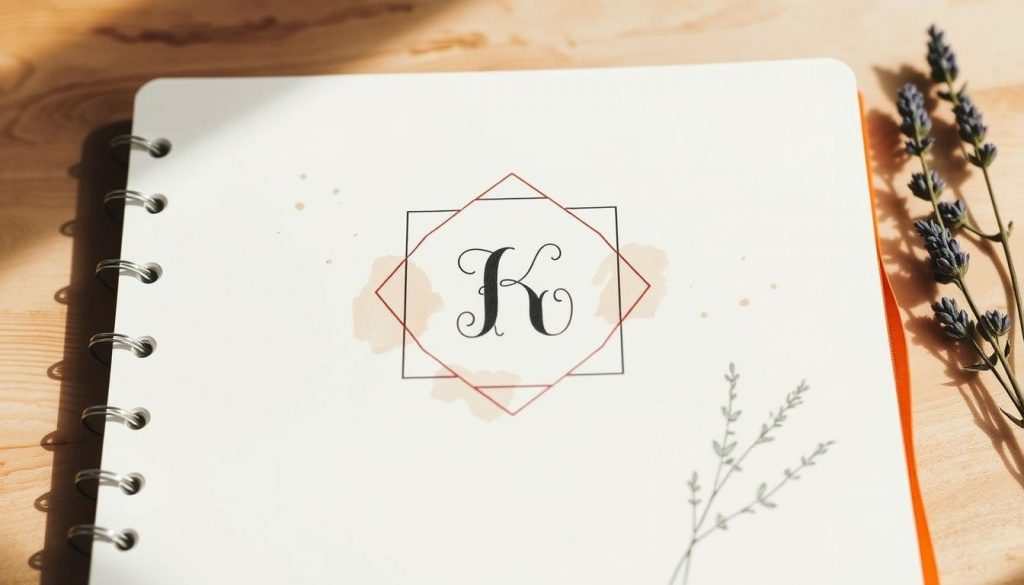
Customization is key in hybrid journaling. Studies show that personalizing your journal increases satisfaction with planning. This approach helps you manage life’s changes more effectively.
Incorporating Personal Themes
Start by identifying your core interests. Create themed sections that reflect your passions. This makes your journal truly unique.
- Travel adventure log
- Fitness and wellness tracker
- Creative project portfolio
- Personal growth reflection pages
Adding Custom Pages for Your Interests
Many Bullet Journal users customize their systems. Your journal can include pages that match your lifestyle. Here are some ideas:
- Book reading tracker
- Gratitude log
- Goal visualization spread
- Financial planning section
Experimenting with Different Styles
Flexibility is essential in bullet journaling. Many users prefer simple layouts that focus on function. Don’t be afraid to experiment and find what works best for you.
Your bullet journal is a living document that grows and changes with you.
Your personalized bullet journal should support your growth. Design it with intention and creativity. This will help you develop a method that feels uniquely yours.
Maintaining Consistency in Your Journaling
Building a lasting journaling habit takes commitment and smart planning. A thoughtful writing routine can boost your productivity. Let’s explore ways to create a consistent journaling practice for personal growth.

Establishing a Routine
Consistency is key to effective journaling. Regular journaling offers significant benefits to individuals.
These include a 40% drop in anxiety, 70% better emotional clarity, and 25% improved self-awareness.
- 40% reduction in anxiety levels
- 70% increased sense of emotional clarity
- 25% improvement in self-awareness
“Journaling is not about perfection, but about persistent reflection.” – Anonymous
Daily vs. Weekly Journaling Practices
Your journaling style should fit your life. Daily rapid logging suits some, while others prefer weekly deep dives.
Try these strategies to find what works for you:
- Set aside 5-10 minutes daily for quick entries
- Choose a consistent time that fits your schedule
- Be flexible with your writing format
Overcoming Common Obstacles
Many people find it hard to keep journaling. Time limits and low motivation are common issues. Bullet journaling offers flexibility, so missed days aren’t failures.
About 63% of people find simple prompts help them journal more regularly. Tracking progress is good, but don’t let perfectionism stop you.
Around 80% of those who use specific prompts find it easier to write often.
“Your journal is a safe space for exploration, not judgment.” – Journaling Expert
Find your own journaling path. A method that fits your style will help you stay consistent.
Transforming Your Bullet Journal into a Life Planner
Bullet journaling offers a dynamic approach to organization and productivity. It’s more than a notebook—it’s a tool for personal and professional growth. The Bullet Journal Method helps you create a custom life planning system.
This system adapts to your unique needs. It empowers you to maximize productivity and practice reflective journaling.
Let’s explore strategies to turn your journal into a comprehensive life planner. These tips will boost your productivity and enhance your reflective practices.
Organizing Tasks and To-Do Lists
Creating an efficient task management system requires strategic thinking. Consider these key approaches:
- Develop a consistent migration process for tasks
- Use collections to categorize different types of tasks
- Implement an icon key for quick task identification
Finding Balance Between Work and Personal Life
Bullet journaling integrates work and personal goals effectively. Intentionality is crucial when designing your spreads. Create sections to track both professional achievements and personal growth.
| Planning Aspect | Work Focus | Personal Focus |
|---|---|---|
| Goal Setting | Professional milestones | Personal development |
| Habit Tracking | Productivity metrics | Wellness and self-care |
| Weekly Review | Project progress | Personal reflections |
Reflecting on Progress and Adjustments
Regular reflection turns your journal into a powerful personal development system. Implement a monthly review process to improve your planning approach.
This process helps you assess completed tasks and identify productivity patterns. It also allows you to make intentional adjustments to your planning methods.
- Assess your completed tasks
- Identify patterns in your productivity
- Make intentional adjustments to your planning approach
These strategies will help you create a comprehensive life planner. Your bullet journal will support your organization, productivity, and personal growth effectively.
Celebrating Your Bullet Journaling Journey
Bullet journaling is more than organizing tasks. It’s a creative journey of self-discovery. Over four years, you’ve likely grown, especially while juggling parenthood and multiple responsibilities.
Your journal reveals the power of mindful writing. It’s a tool for understanding health, emotions, and personal growth. Habit trackers and documented experiences create a unique roadmap of your evolution.
The bullet journaling community can boost your progress. Instagram and Pinterest offer inspiration and support. Sharing your spreads motivates you and helps others discover bullet journaling’s potential.
Your approach ensures no two journals are alike. Set meaningful milestones to keep momentum. Celebrate small wins like consistent tracking or new layouts.
Your bullet journal shows your commitment to growth. It’s a testament to your journey of self-understanding. Keep exploring and evolving through this powerful practice.
FAQ
What is the difference between bullet journaling and traditional journaling?
Do I need special supplies to start a combined bullet and traditional journal?
How much time should I dedicate to journaling each day?
Can I use digital tools with my hybrid journaling approach?
What if I miss days in my journal?
How can I make my bullet journal more creative?
Is bullet journaling good for mental health?
How do I start integrating traditional journaling into my bullet journal?
What symbols should I use in my bullet journal?
How can I use my bullet journal for goal setting?
Source Links
- How to Long-form Journal In Your Bullet Journal
- Thorough Guide to the Bullet Journal System — Tiny Ray of Sunshine
- Bullet Journal: Work & Personal Combination
- How to Start a Bullet Journal for Beginners
- Bullet Journaling 101: The Ultimate Setup Guide for Beginners
- How to Start a Simple Bullet Journal
- How to Start a Bullet Journal for Beginners
- How to Start a Simple Bullet Journal
- Free Bullet Journal Reference Guide — Tiny Ray of Sunshine
- Ultimate Guide: How to Setup a Bullet Journal – The Olden Chapters
- Cloth & Paper’s Guide to Bullet Journaling
- How to Bullet Journal: The Absolute Ultimate Guide — The Lazy Genius
- How to Start a Bullet Journal for Beginners
- Intentional Habit Tracking
- Using the Bullet Journal for Self-Care
- Changing Your Bullet Journal To Make the Method Work for You
- How To Set Up A New Bullet Journal – From Carola
- How to Start a Bullet Journal for Beginners
- Embracing Messy & Inconsistent Journaling
- How to Long-form Journal In Your Bullet Journal
- My Top 5 Tips to staying consistent in your Bullet Journal and Planner
- Changing Your Bullet Journal To Make the Method Work for You
- How I Started A Bullet Journal to Live Intentionally – Alexis Donkin
- Using the Bullet Journal for Self-Care
- Bullet Journaling For Beginners — MODA MAGAZINE
